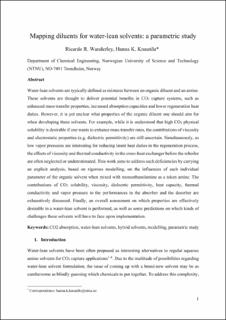| dc.description.abstract | Water-lean solvents are typically defined as mixtures between an organic diluent and an amine. These solvents are thought to deliver potential benefits in CO2 capture systems, such as enhanced mass transfer properties, increased absorption capacities, and lower regeneration heat duties. However, it is yet unclear what properties of the organic diluent one should aim for when developing these solvents. For example, while it is understood that high CO2 physical solubility is desirable if one wants to enhance mass transfer rates, the contributions of viscosity and electrostatic properties (e.g., dielectric permittivity) are still uncertain. Simultaneously, as low vapor pressures are interesting for reducing latent heat duties in the regeneration process, the effects of viscosity and thermal conductivity in the cross-heat exchanger before the reboiler are often neglected or underestimated. This work aims to address such drawbacks by carrying out an explicit analysis, based on rigorous modeling, on the influences of each individual parameter of the organic solvent when mixed with monoethanolamine as a token amine. The contributions of CO2 solubility, viscosity, dielectric permittivity, heat capacity, thermal conductivity, and vapor pressure to the performances in the absorber and the desorber are exhaustively discussed. Finally, an overall assessment on which properties are effectively desirable in a water-lean solvent is performed, as well as some predictions on which kinds of challenges these solvents will have to face upon implementation. | en_US |
